- Common Stihl 500i Problems & Troubleshooting - January 14, 2023
- Best Firewood Kindling Splitter - November 21, 2022
- How to Find the Best Hewing Axe - November 8, 2022
Firewood will keep for many years if you just keep it dry and ventilated. While I highly recommend a real woodshed for anyone that intends to use wood heat regularly, this might not be a top priority when you first move to a location. This is why it is good to have some firewood covering ideas to get you through until you can decide where you want your permanent firewood storage and when you can make the investment.
Knowing how to cover firewood properly allows you to purchase or cut fresh logs and then dry them out yourself. If you are new to wood heat, you will quickly learn that “green” firewood costs less than wood that someone has cut and allowed to dry before selling it to you.
My family has always used wood heat. As a child, we used wood heat exclusively to keep warm through cold and damp Northwest winters. As an adult living with my husband and child at 3,000 feet in the mountains of North Carolina, we rely on wood heat to reduce heating costs.
We try to use wood as much as possible since we have a 5 acre woodlot to harvest firewood from, but we also have central electric heat for times when we do not feel like burning a fire or it is not quite cold enough to justify building a roaring fire. Our small house is well insulated, so it doesn’t take much of a fire to create too much heat if outdoor temperatures are just a bit cool.
Over the years, we have tried various methods for covering firewood. In this best firewood covering ideas guide, I will explore some of these methods and a few that I have not tried as well.
My Bottom Line Up Front for Best Firewood Covering Idea: If you are on a strict budget, then a tarp is my pick for best firewood covering as long as it allows some airflow for drying out the wood. If you have a little more to spend, then a Cordwood Cover is what I recommend for a more long term solution without having to spend money on a woodshed. For ultimate long-term firewood storage, a woodshed is the best option.
Interesting Read: The Best Types of Firewood.
How I Chose My Top Picks
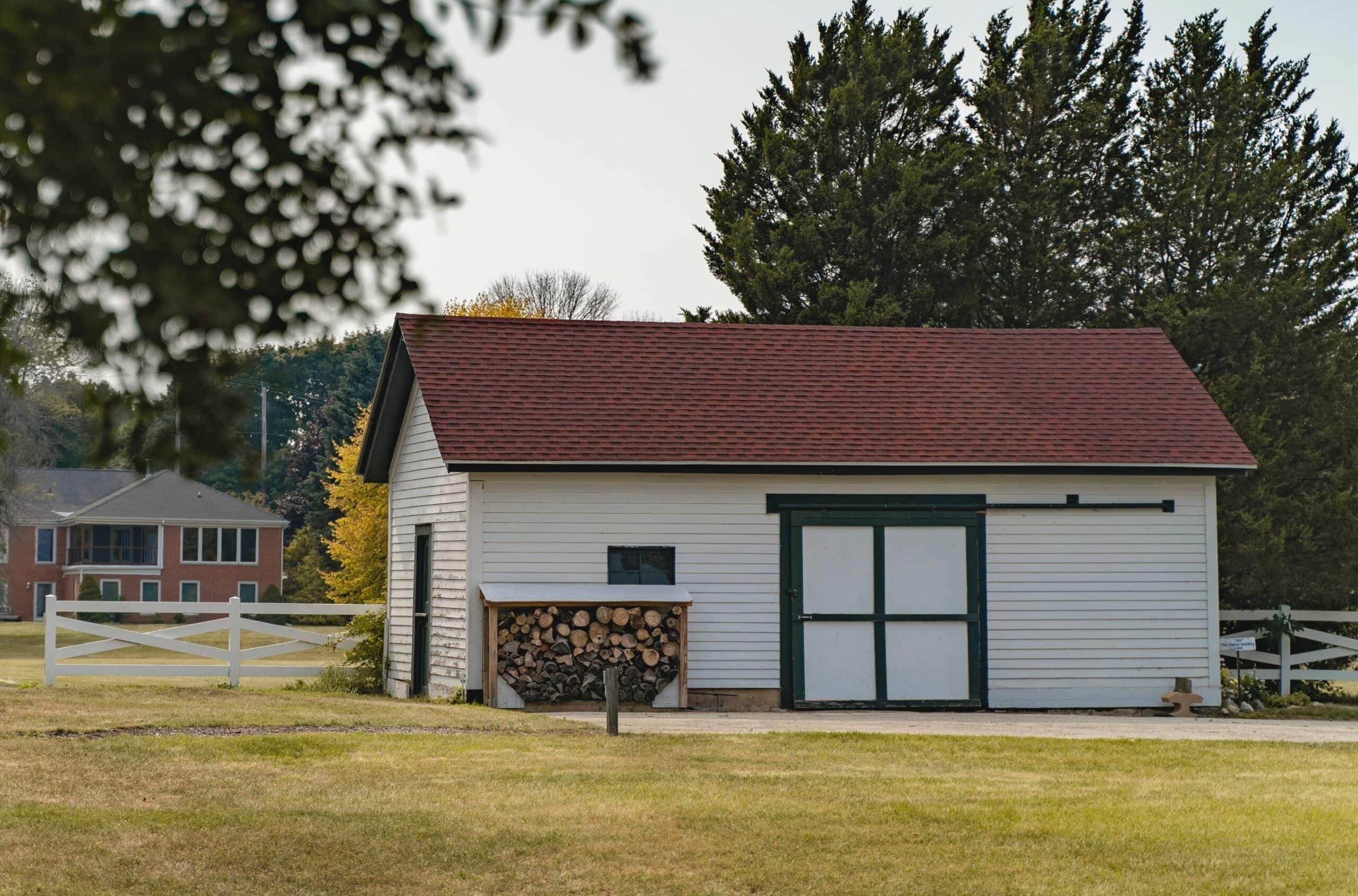
Cost
It is important to know your options for covering firewood no matter what type of budget you are on. From a $10 tarp to a full size permanent woodshed, there are options out there for keeping your wood dry.
Availability
All the methods I chose are easy to find or purchase the materials to build. Tarps can be found at any big box store, hardware, or camping store, as well as online retailers like Amazon. Building materials such as brackets and 2x4s also have excellent availability.
Durability
It is important that even the least expensive method is able to withstand a full year of being exposed to bad weather and some sunlight.
My Top Picks
Cordwood Covers– Best option for long-term wood storage in a small space without the expense of a woodshed.
Woodshed- A properly built woodshed is the best option over the years, as long as you have enough space within a reasonable distance from your home.
Always Consider How Far You Have to Travel in the Winter to Get to Your Firewood Stack When Creating Your Stacks.
There is a reason why some people like to have a firewood rack with a roof on it right outside their door. In the fall and winter, it is no fun to have to walk too far to get to your wood. During an ice storm, it can be practically impossible to make it more than a few feet without major slipping.
A good compromise is to have at least a small rack of wood where you can get to it in just a few steps so you can make sure it is stocked before inclement weather. Your larger stack of wood can be a bit farther away. Of course, if you have a lot of wood stacked throughout your property then you just need to be sure to rotate it so you always have enough.
Plastic Tarp
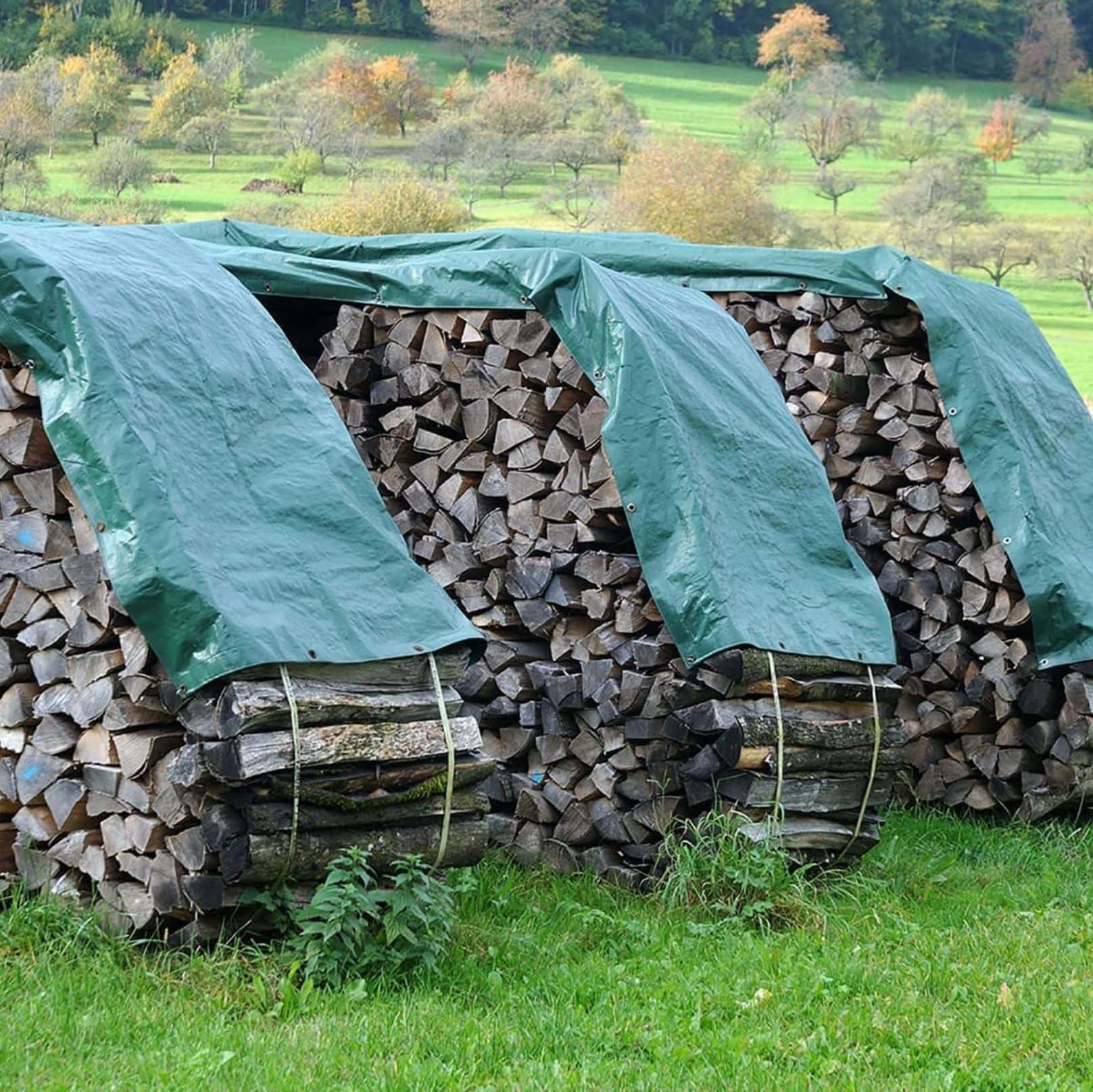
An inexpensive plastic tarp is a great firewood covering, but you need to make sure you use it properly, or you can actually make your wood rot at a really fast rate. A tarp should only cover the top of your stacks of firewood. You need to leave part of the sides uncovered, so moisture has a chance to escape the firewood stacks. You can let your tarp hang halfway down the sides, but no more than that. This is especially important if you are stacking recently cut or wet firewood that you want to dry out.
There are different grades of tarp out there. A less expensive tarp will last at least a season, but it will be more prone to wind damage and abrasion than a tougher grade tarp. No matter what grade of tarp you decide to use, it is imperative to make sure it is secured well, so it doesn’t get blown off or torn about in a storm. Tarps are tough, but they have their limits. Check out the thickness of a tarp before you buy it if you are concerned about durability over time.
Pros
- Inexpensive
- Easy
Cons
- Not a great long-term solution unless you invest in a heavy duty tarp
- Easily damaged if not secured well
Metal Sheeting
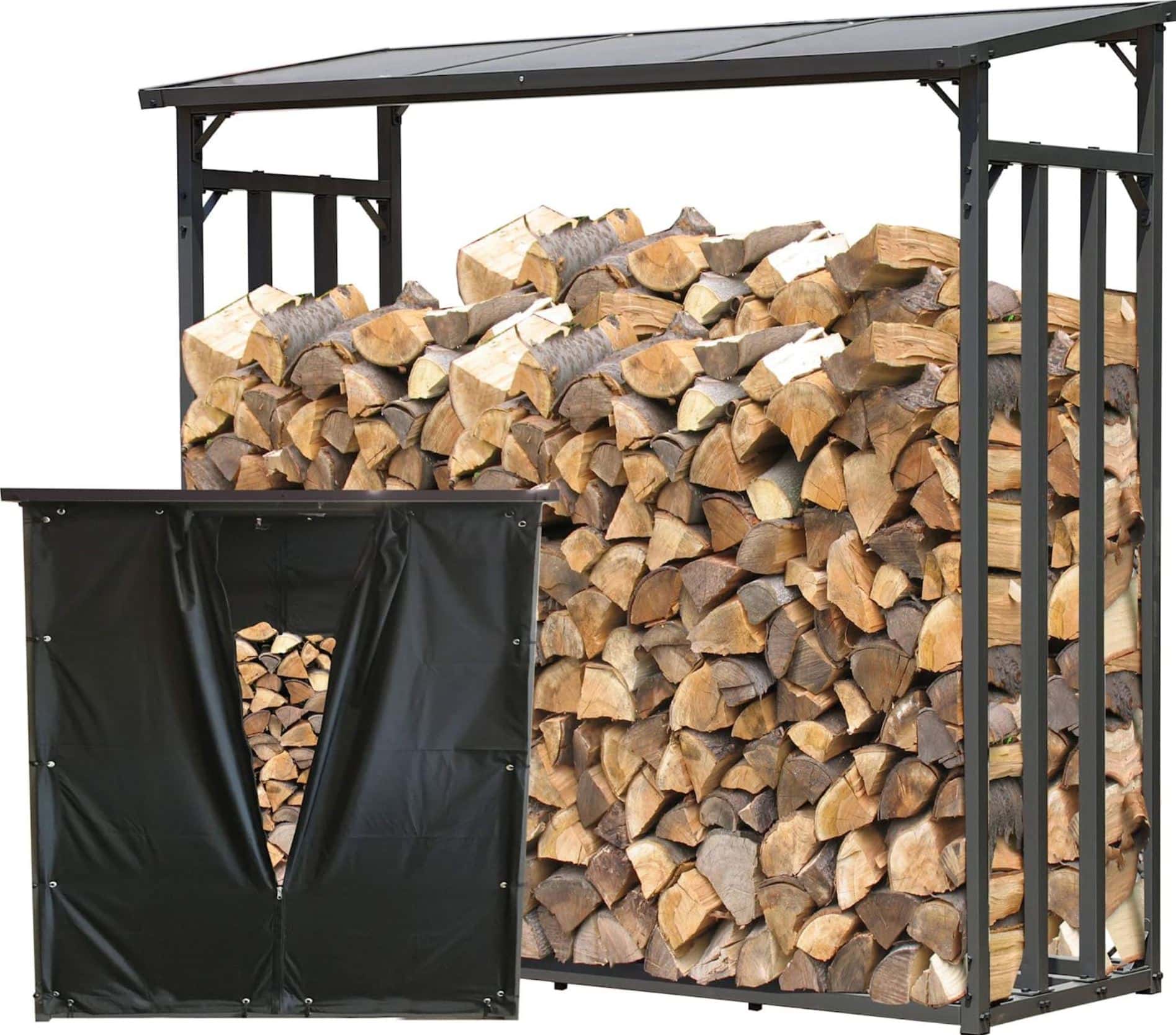
On our homestead, we often use old sheets of metal roofing to cover wood piles. These are sturdy and just have to be weighed down with a few rocks or pieces of wood. Metal sheeting allows wood to breathe on all sides, so it doesn’t rot quickly due to trapped moisture. Wood dries out quite nicely under metal sheets. This is a good temporary fix if you need to stack wood away from your regular woodshed or you are not quite ready to build a permanent structure.
Pros
- Tough and durable
- Can use old upcycled sheets
Cons
- Cost
- Must be weighed down well to prevent blowing away
Woodshed
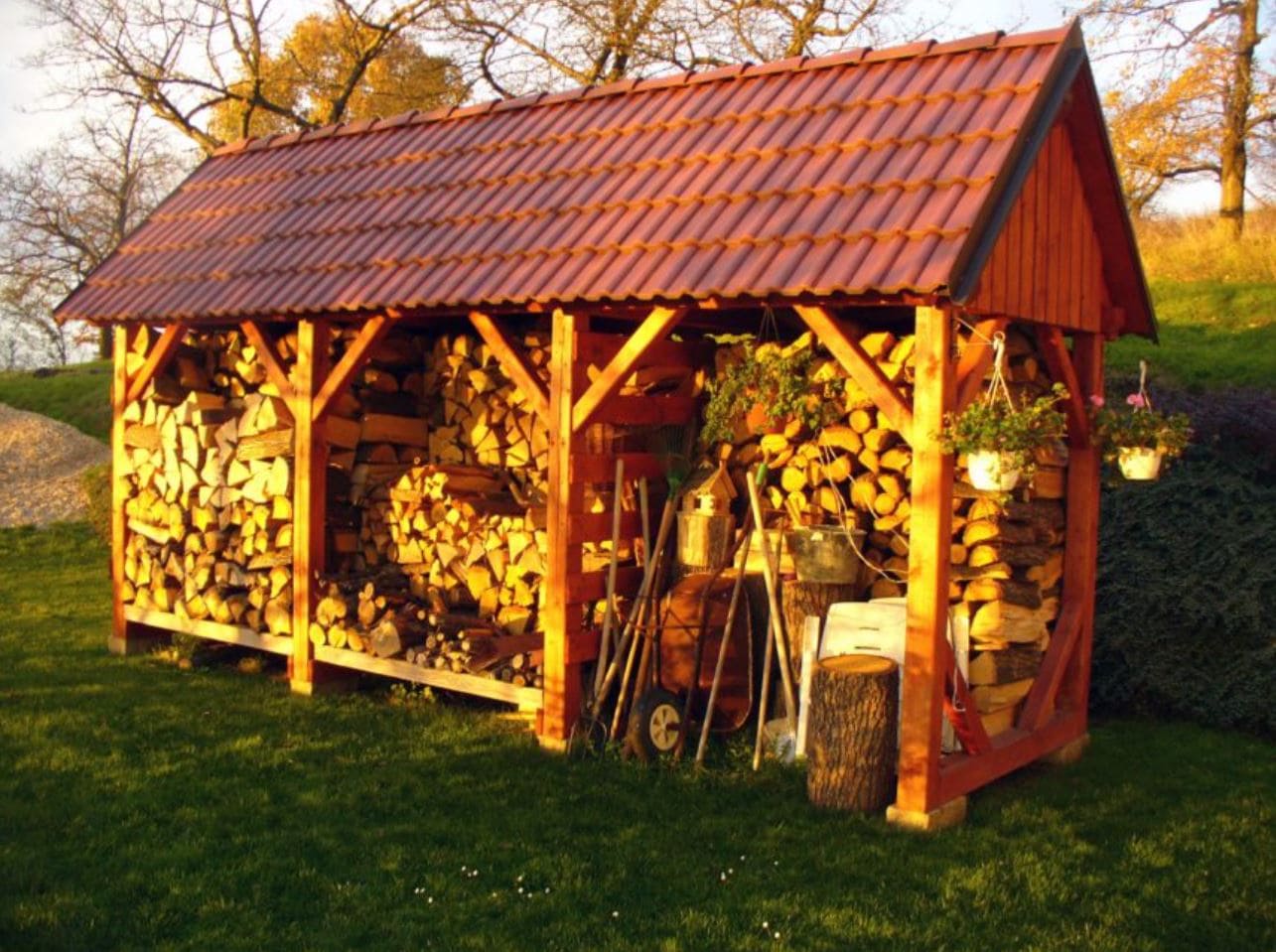
If you are burning firewood every year, then eventually, you should build a woodshed if you have the space. A firewood shed helps allow you to purchase firewood in a larger quantity, and it offers total protection from whatever the weather in your region can throw at it.
One of the easiest and least expensive sturdy woodshed designs is to use four treated 4x4s or similar treated boards for a roof structure, and painted sheet metal. Sinking each post in concrete or using Simpson post bases is going to be required.
Another option is to pour concrete tubes partially in the ground and partially above and use that to set a post base and post. A simple shed style roof will allow rain and snow to fall off easily. Boards nailed around the structure can provide support for stacked rounds.
Pros
- Permanent
- Sturdy
- Total protection
Cons
- Requires dedicating a permanent portion of your property to a storage shed
- Costs more upfront
Firewood Rack with Small Roof
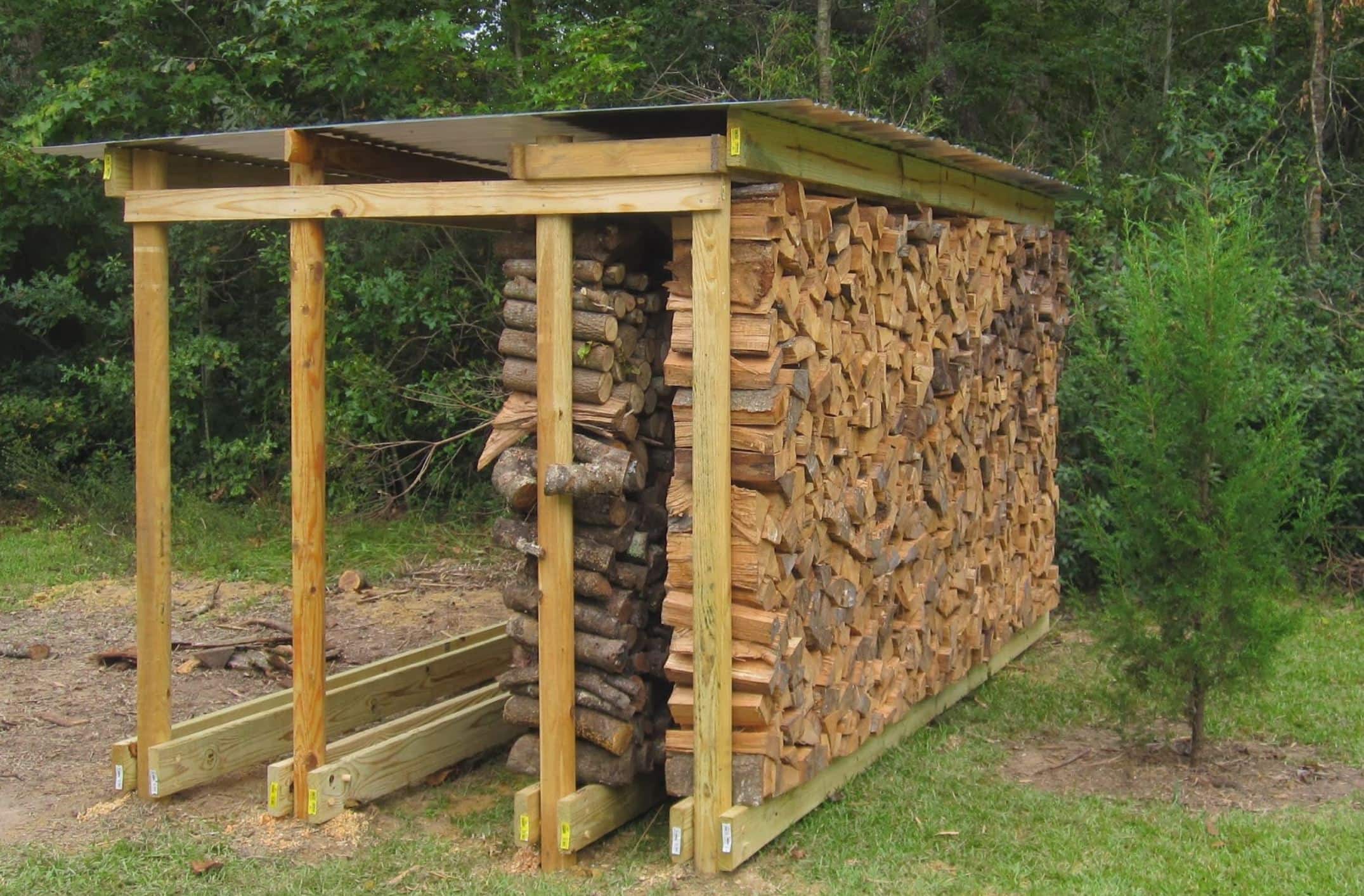
A basic outdoor firewood rack with a roof is smaller and costs less to build than a woodshed. Even if you have a woodshed, it’s nice to have a covered rack closer to the entry point of your home, so you don’t have to slog all the way to your shed to get some logs to burn during nasty weather.
Remember that during a snow or ice storm, reaching firewood that is further away than just a few steps increases the chances you are going to fall and hurt yourself. I know this because during some ice storms at my house at 3,000 elevation in the mountains of North Carolina, I have found myself crab walking to get a few feet away and still slipping and sliding.
Pros
- Can build very close to your house
- Inexpensive
Cons
- No back wall for support
DIY Firewood Rack Brackets and Choice of Cover
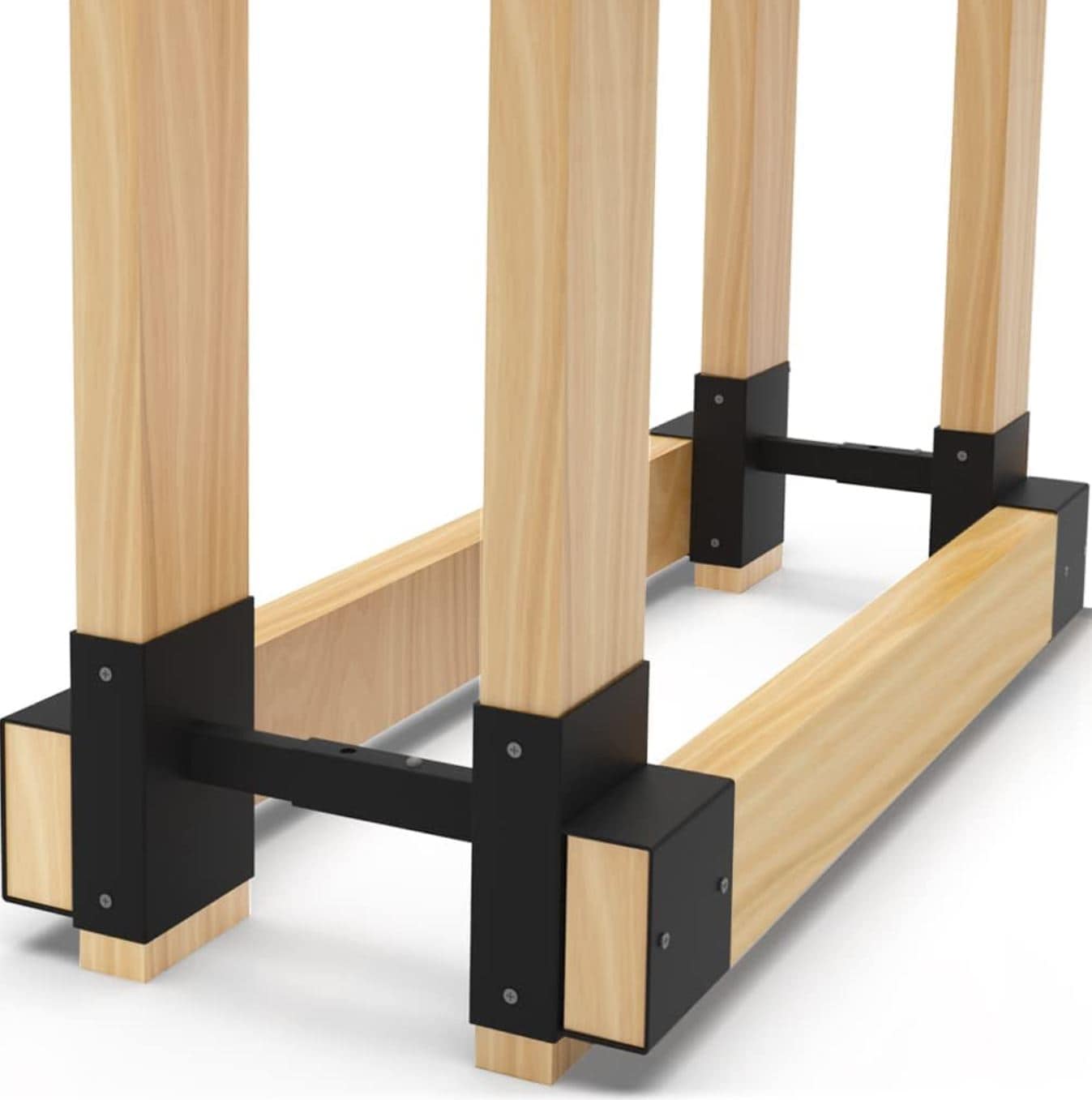
There are some really strong brackets out there for building firewood racks. You will need to buy some 2x4s and have a saw on hand to cut them with. A drill for screwing in the brackets is another necessary tool.
I have seen people use these brackets and then sit the entire rack on cinder blocks in order to create air flow under the stack and eliminate moisture from the ground. You can buy a cover or use a tarp to cover your stack of wood if you want something easy.
It is not too difficult to add a roof to the top of this style of rack. You can even just run a single board on the top and attach a piece of metal roofing. You will want to secure the ends of the sheet metal to the top of the 2x4s on either end to make sure it is not too flimsy if the wind hits it.
Pros
- Save money building your own rack
- Simple to build
- Customize your rack size
Cons
- Takes some time and a few tools to build
- Need to buy lumber from your local hardware store
Rack and Cover Combos
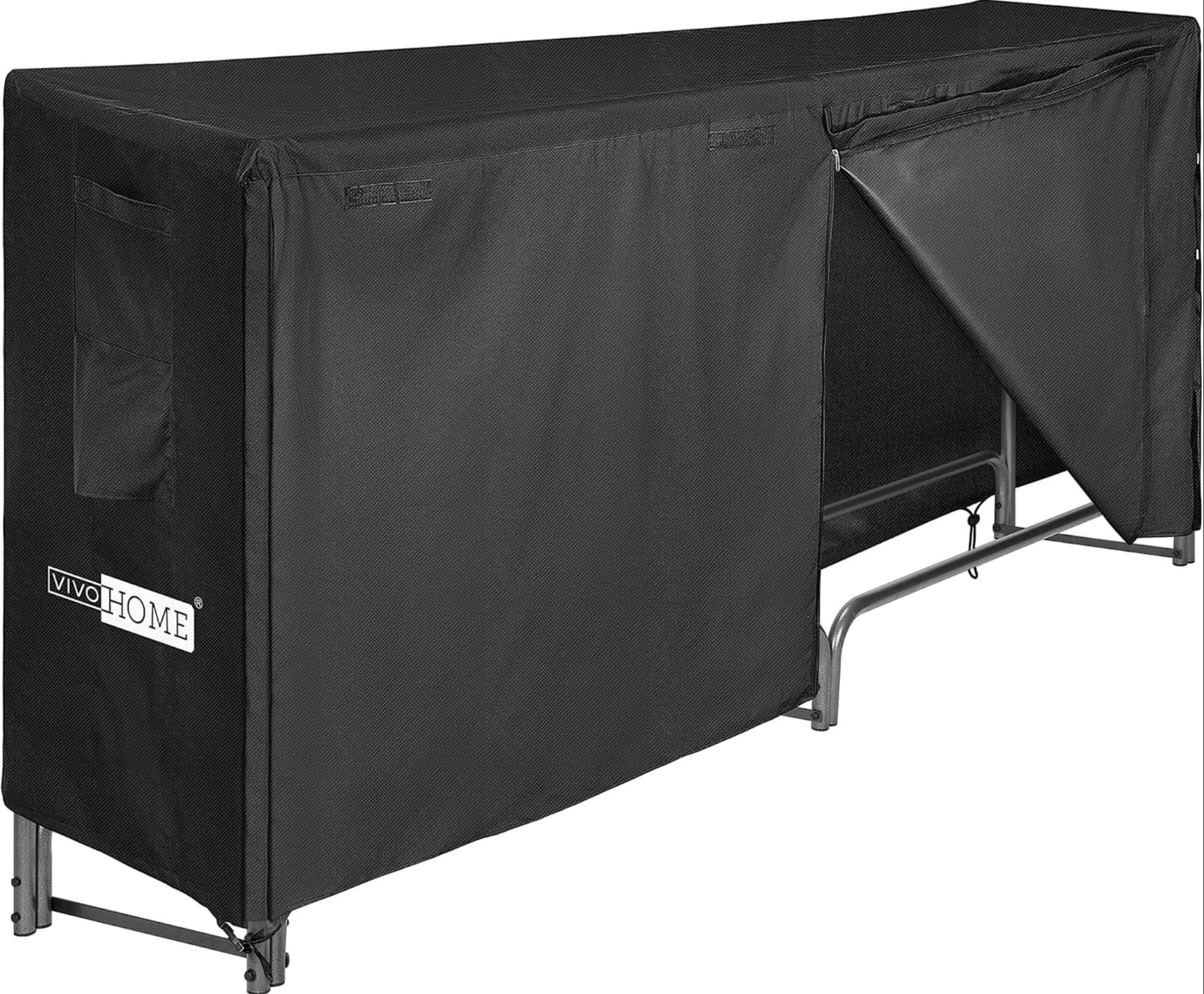
There are a ton of firewood racks with included covers that you can order from Amazon and assemble in practically no time at all. These combos are a great solution if you want a rack of wood close to your house that you can access easily.
Although you can get racks that are up to 12 feet, the racks only hold a single rack of wood, so storage is rather limited, making these types of racks only practical for either those that do not burn a lot of wood or that want some storage away from their main woodshed or wood storage area.
Pros
- Easy to assemble
- Fast solution
- Portable
Cons
- Limited firewood storage
- Some racks have covers that cover the entire rack, so you may need to roll the cover up slightly if you are trying to dry out wood
Cordwood Covers
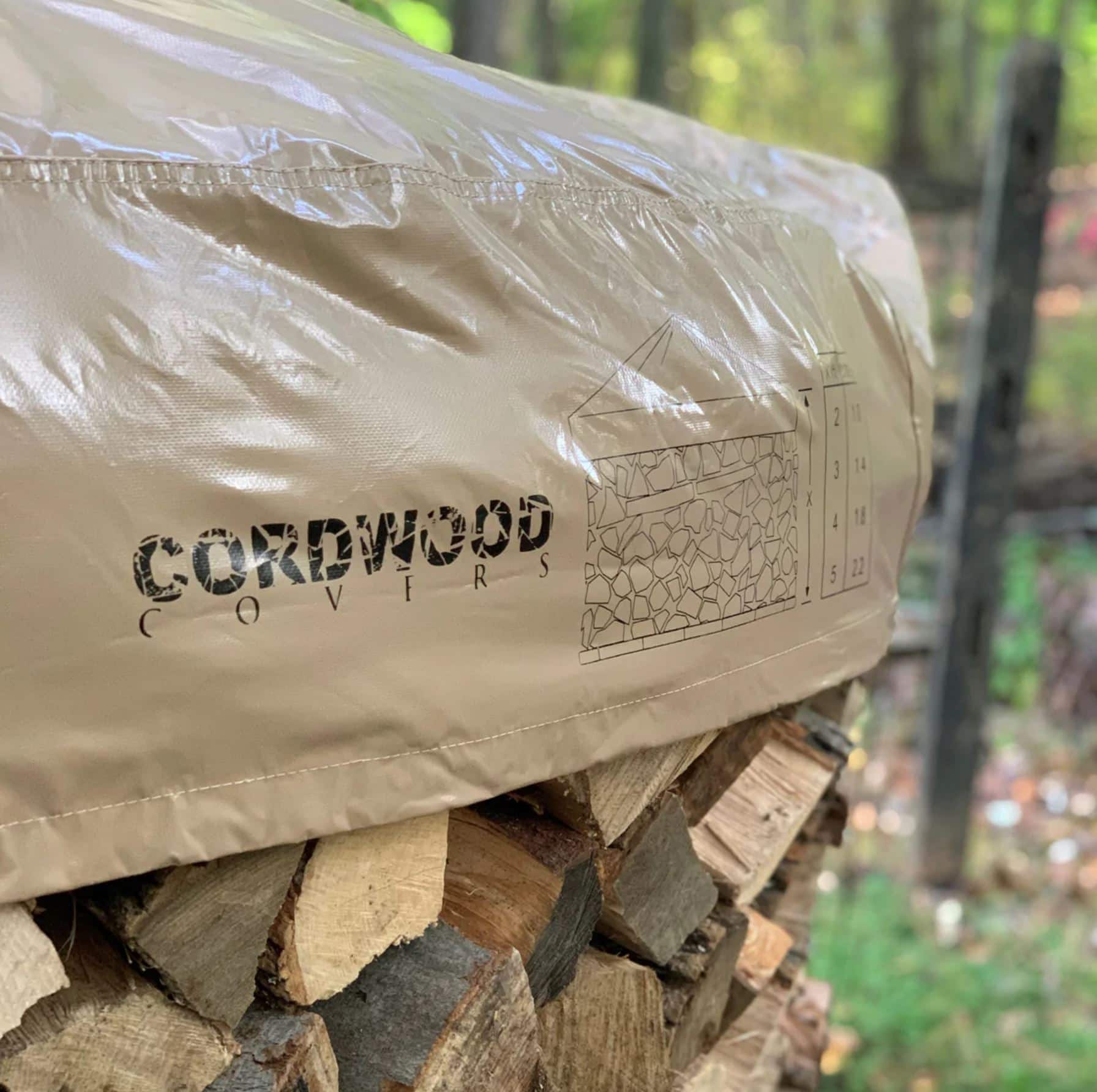
Cordwood covers are designed to cover the top of a pile of wood stacked using an old German method for storing a large quantity of firewood in a single space. Using a cordwood cover is an excellent alternative to building a woodshed and will work just as well. Sure they are more expensive than a tarp but you get a much sturdier product and a ground cloth as well.
With a Cordwood cover, you can stack two cords of firewood in an 8 ft diameter circle. At under $200, this is a reasonable option for those that want something better than a tarp but do not want the permanence or expense of a woodshed.
Cordwood Covers are also excellent for those that need to store firewood in a more remote area on their property, at least temporarily. For example, if you cut extra wood that you do not know that you will need for the coming winter, you can store it where you cut and split it and then bring it to your home later. This can be helpful if you do not want to have more wood than you need for a winter stacked near your home.
Pros
- Easy to use
- More heavy duty than a tarp
- Vents at top for superior ventilation without letting in rain
Cons
- Eventually, wear out
- Limited coverage per cover
- Requires following a specific stacking method
How to Stack Firewood
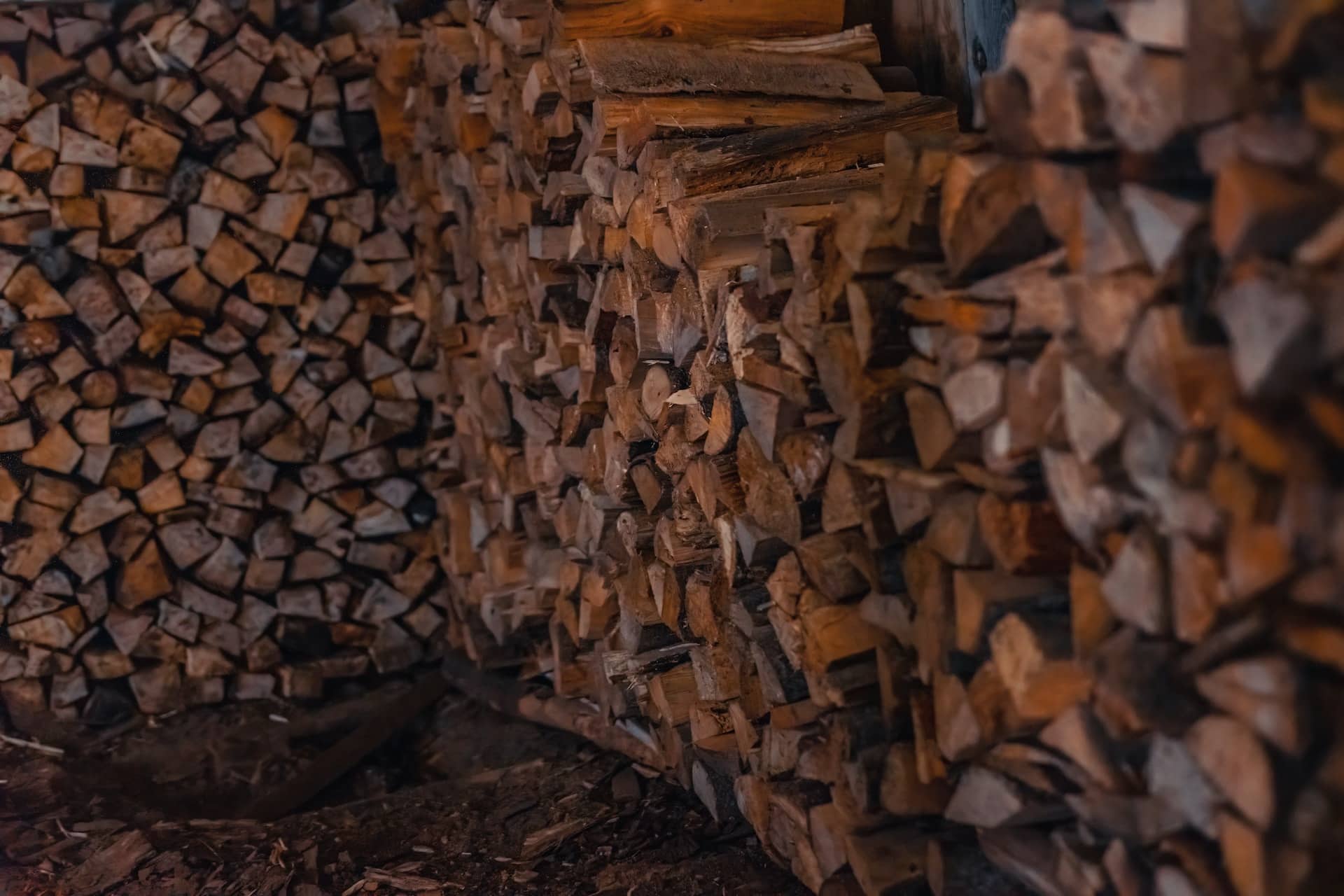
Stacking wood is pretty straightforward, but there are a few things that you need to keep in mind if you are new to firewood storage and wood heat. Here are some tips to make things safer and easier throughout the log burning season.
Never Stack Wood so High That it is Unsteady.
The last thing you want is your stack to fall over and hurt someone, or even just fall over so you have to restack it again.
You can stack wood as high as you can reach, but only if you do it in a way that it is stable. This means you need something on the sides or behind your stack to support it unless you are sticking to shorter stacks. Even just a few well-placed poles or fence posts in the ground can be a big help.
Make Sure You Stack so Your Stack Doesn’t Jut Out the Higher Up You Go.
You can build a lean into your stack that makes it unsteady and doesn’t make the best use of your space. Stack as straight and uniform as possible to create a safe and secure stack of wood.
Stack Wood so That What You Need to Burn First is the Easiest to Access.
For example, you will want to burn your oldest firewood first. If you have wood left over from the year before, you may want to consolidate it so you don’t stack your newer wood on top or in front of it. You may also want to make sure that you save your best firewood for the coldest months of the year, so that is something to consider when stacking.
The Bottom Line: Best Firewood Covers
There are a lot of great firewood cover options out there, regardless of your budget, space, or how much time you have. You should decide what is the best firewood cover for you based on your personal circumstances.
Of course, this may change over time, and it may vary depending on how often you choose to use your woodstove from season to season.
Choose a Cordwood Cover when you want to store a lot of firewood without spending a ton of money. When you have the space and time, a permanent woodshed should be part of your plan if you intend on using wood heat a lot.
FAQs
Question: How Much Firewood do I Need to Store?
Answer: Firewood needs vary based on a lot of factors. You need to consider how well insulated your home is, if you are using wood heat as a main source of heat or just as a supplement, the size of your home, and the region you live in. It can take a few years of burning to get a really good idea of your family’s unique needs. Also, you might have a cool season that lasts longer or is shorter.
I find that it is a good idea to ask others that use wood heat in your area how much they typically go through, and that is a good starting point, especially if they have a home similar to yours.
Question: What are the Best Types of Firewood?
Answer: Hardwoods like locust, oak, and hickory are considered the best firewood. This is followed by cherry, maple, and poplar. Softwoods like pine and hemlock will burn just fine but are not as dense and thus do not put out as much heat all at once, nor do they burn as long.
Hardwoods, especially the prime ones like locust, oak, hickory, and cherry, cost more to buy, but you burn less of them. Just plan on using more wood if you need to burn less desirable wood species to heat your home.
Question: How Long Will Firewood Last in Storage?
Answer: Firewood will last indefinitely under ideal conditions. The better you store your wood, the longer it will last. The drier you keep your wood, the longer it will last. It is possible to store many winters’ worth of firewood if you happen to catch a good deal or have a lot of wood that needs to be removed from your woodlot.
Wood that is on the outside of a stack tends to be exposed to more moisture, so it deteriorates faster and should be burned first.
Conclusion
Covering up your firewood is essential if you want to ensure it dries out properly and burns well. You also need to continue to keep it covered so that rain and snow don’t make it so wet that it’s hard to burn. Burning wet firewood contributes to soot in your chimney, meaning you have to clean it more often. This is not to mention how frustrating it is to try to start a fire when your wood is wet.
Covering your wood while allowing room for ventilation is achievable a variety of ways even if you are on a strict budget. Firewood rack brackets provide an affordable DIY solution, especially when combined with a tarp or a piece of sheet metal roofing.
If you want to store a lot of wood without the expense of a woodshed, a Cordwood Cover is your best bet.


